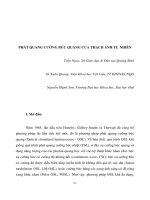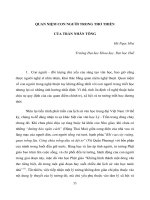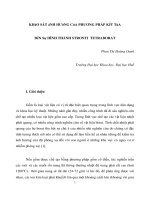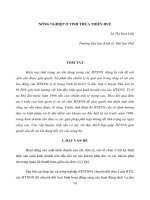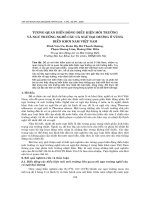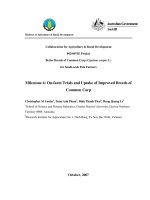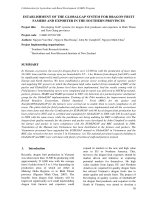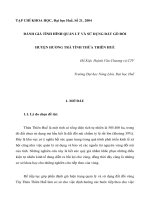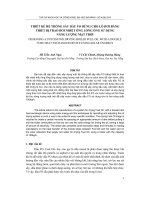Báo cáo nghiên cứu khoa học: "Hút thuốc ở người dân lào: Thách thức và cơ hội kiểm soát thuốc lá" pptx
Bạn đang xem bản rút gọn của tài liệu. Xem và tải ngay bản đầy đủ của tài liệu tại đây (116.68 KB, 20 trang )
519
JOURNAL OF SCIENCE, Hue University, N
0
61, 2010
SMOKING AMONG LAO MEDICAL DOCTORS:
CHALLENGES AND OPPORTUNITIES FOR TOBACCO CONTROL
Sychareun Vanphanom, Alongkone Phengsavanh
Visanou Hansana , Sysavanh Phommachanh
University of Health Sciences, Faculty of Postgraduate Studies, Lao PDR, P.O. Box 7444,
Vientiane, Lao PDR.
Martha Morrow
Nossal Institute for Global Health, The University of Melbourne, Vic 3010, Australia
Tanja Tomson
Department of Public Health Sciences, Div. of Social Medicine, Norrbacka 2
nd
floor,
Karolinska Institutet, SE-171 76 Stockholm, Sweden
SUMMARY
Smoking is an increasing threat to health in low and middle income countries. Doctors
are recognised as important role models in anti-smoking campaigns. Objectives: To identify the
smoking prevalence of medical doctors in Laos, their tobacco-related knowledge and attitudes,
and their involvement in, and capacity for tobacco prevention and control efforts. Methods: A
cross sectional national survey by a researcher-administered, face-to-face questionnaire
implemented at provincial health facilities throughout the Central (including national capital),
Northern, and Southern regions of Laos in 2007. Both descriptive and inferential statistics were
used. Results: Of the 855 participants surveyed, 9.2% were current smokers and 18.4% were ex-
smokers; smoking was least common in the Central region (p< 0.05) and far more prevalent in
males (17.3% vs. 0.4%; p<.001). Smoking was concentrated among older doctors (<.001). Over
84% of current smokers wanted to quit, and 74.7% had made a recent serious attempt to do so.
Doctors had excellent knowledge and positive attitudes to tobacco control, although smokers
were relatively less knowledgeable and positive on some items. While 78% of doctors were
engaged in cessation support, just 24% had been trained to do so, and a mere 8.8% considered
themselves ‘well prepared’. Conclusion: The willingness of doctors to take up a role in tobacco
control role in order to contribute to lowering smoking rates among younger respondents offers
an important window of opportunity to consolidate their knowledge, attitudes, skills and
enthusiasm as cessation advocates and supports.
Keywords: Medical doctors, smoking, Lao PDR, tobacco control, prevalence,
knowledge, determinants.
520
1. Introduction
Historical evidence from high income countries suggests that smoking rates in
the general population followed – at some distance in time – increases and decreases in
prevalence among doctors. Doctors are seen as role models by the public, patients and
their colleagues and as such can act in reducing societal smoking prevalence and thus
contribute to stemming the projected increase in mortality and morbidity from tobacco-
related diseases. By contrast, health professionals who smoke ‘send an inconsistent
message’ to patients whom they have urged to quit.
Laos (The Lao People’s Democratic Republic) is a landlocked Southeast Asian
nation of approximately 6.2 million people, about 27% of whom live in urban areas.
Most recent estimates put life expectancy at birth at 65 years and literacy rates (age
15+) at 73%. Laos is a low-income country, with 32% of children under five
malnourished, although economic growth reached 7.5% per annum in 2008. Up to half
of district hospitals do not have fully qualified medical doctors.
Smoking prevalence in male doctors at Mahosot University Hospital in the Lao
capital, Vientiane, in 2003 was found to be 35%. In the same year a national survey
found 40.3% of the population were smokers, with rates among males over four times
those of females (67.7% vs. 16%). This large disparity by sex is found in neighbouring
countries, reflecting gender norms that encourage male and discourage female smoking.
Smith and Leggat argue that convincing the public of tobacco’s dangers may be difficult
if doctors are smoking, so monitoring their smoking behaviour is important. Data
related to tobacco use patterns, knowledge, attitudes and determinants among health
professionals in Laos are scarce. This study was undertaken in 2007 to document Lao
doctors’ current smoking prevalence, knowledge and attitudes towards smoking as well
as control efforts, and to investigate associations between variables.
2. Methods
Laos has 17 provinces plus the Capital City (a separate administrative entity).
The system of formal health service provision is provided by hospitals, primary health
care (PHC) and vertical programmes. The hospital system comprises facilities at Central,
Regional, Provincial, and District levels.
Three provinces were chosen purposively in each of the country’s geographical
zones. Northern provinces included Luangprabang, Oudomxay and Xiengkhouang;
Southern provinces included Champassack, Saravanne and Attapeu. Central provinces
included Vientiane Capital City, Vientiane province, Khammouane, Savannakhet and
Bolikhamsay; Vientiane Capital City (regarded as norm-leading) was also added, for a
total of ten study sites. These provinces were chosen because of their relatively high
521
population density and greater number of medical doctors. They were diverse in terms
of socio-economic development. The Central region is the most affluent. Respondents
were sourced from provincial hospitals, province-level health departments, and (for
Vientiane) the University of Health Sciences (former Faculty of Medical Sciences), four
central hospitals, and nine centres involved in prevention and control of diseases.
District hospitals were excluded due to low numbers of medical doctors.
The sampling frame for each province/ capital city comprised a full list of all
fully-trained medical doctors in these facilities or organisations. The list numbered 1060
across all provinces. Each doctor on the list was invited to participate. Researchers
administered a face-to-face structured questionnaire that was a modified version of the
WHO’s Global Health Professionals Survey (GHPS). The instrument included questions
on socio-demographics; smoking knowledge, attitudes and practices; and intention to
participate in tobacco control. Socio demographic characteristics covered age, sex,
ethnicity, religion, residency, qualifications and years of experience. Knowledge
covered tobacco’s health, social and environmental impacts. Attitudes were ascertained
from responses to 15 questions covering views on anti-smoking campaigns, banning of
cigarette advertising, health warnings, pricing of cigarettes, doctors as role models,
promotion of smoke free zones, cessation support and integration of tobacco concerns
into curriculum or training. Questions about intention to participate in tobacco control
activities, and the smoking environment at their workplaces were also asked.
Information on smoking status and consumption, age of initiation, quit attempts,
expenditure on tobacco and exposure to second-hand tobacco smoke was also gathered.
For knowledge, true or false questions were asked. A likert scale of 4 scores was
used to measure the questions concerning attitudes (1=strongly disagree, 2=disagree,
3=agree and 4=strongly agree).
The eight interviewers had medical backgrounds from the Postgraduate Studies
and Research Department, University of Health Sciences. A pilot study was conducted
with lecturers, pharmacists and dental health professionals from the University of
Health Sciences, after which the questionnaire was modified. The fieldwork was
supervised by the first author. Ethical clearance was obtained from the National Ethical
Review Board for Research, Ministry of Health, Vientiane (ref No 132/NECHR).
Informed consent was obtained from each respondent.
Data analysis
The data were checked for completeness and validity and entered into Epi Info,
then analysed using SPSS 10.0. Frequency distributions were used to describe the data.
Smoking status among doctors was grouped into three categories: 1/ Current
smokers (occasional and daily smokers at the time of the study); 2/ Ex-smokers (former
smokers who had stopped); 3/ never-smokers (never tried a cigarette in their lifetime).
522
Bivariate analysis was used to measure associations between selected variables
by region and by smoking status, with statistical significance based on the chi-square
(χ
2
) and Fisher’s exact test for independence for categorical variables, and a t-test for
continuous variables.
Adjusted odds ratios and 95% confidence intervals were estimated using logistic
regression to identify factors associated with current smoking after controlling for
confounding. Only male doctors were included in the multivariate analysis because of
the small number of female smokers (two). The factors adjusted include age, education,
duties, provision of treatment, knowledge of health consequences of smoking, and
attitudes and perceptions towards tobacco control and the role of doctors.
Two-sided tests of significance were based on the 0.05 level.
3. Results
3.1. Demographic characteristics
Due to unavailability or absence at the time of survey, we were able to enrol a
total of 855 doctors out of 1060, all of whom completed the questionnaires. The
response rate was highest in Vientiane Capital (91.9%), while the lowest were
Xiengkhouang (47.4%) and Khammouane provinces (65.2%).
Slightly more than half the samples (52.9%) were males, with no variation by
sex between regions. However, the number of doctors in the Central region cohort was
much larger than in the other two regions, reflecting their concentration in and around
the capital. The age of respondents ranged from 24 to 65 years. About two thirds had a
basic bachelor’s degree in medicine and 20.6% were specialists. A few (0.8%) had a
PhD and 11.2% had Master’s degrees. In terms of position, 6.5% were directors or vice
directors of provincial hospitals, and about a quarter of them were heads of divisions.
Table 1. Smoking status of physicians by sex and region
Variables
Smoking Behavior
Never smoked
cigarettes
Quit
smoking
Smoke
occasionally
Smoke
every day
P-
value
Sex <.001
Male 220 (48.7%) 155 (34.3%) 35 (7.7%) 42 (9.3%)
Female 399 (99.0%) 1 (0.5%) 1 (0.2%) 1 (0.2%)
Region .049
Northern 60 (67.4%) 19 (21.3%) 7 (7.9%) 3 (3.4%)
52
3
Central 456 (74.5%) 109 (17.8%) 21 (3.4%) 26 (4.2%)
Southern 103 (66.9%) 28 (18.2%) 9 (5.8%) 14 (9.1%)
Age <.001
24-30 yrs 100 (85.5%) 14 (12.0%) 3 (2.6%) 0
31-40 yrs 247 (80.2%) 37 (12.0%) 13 (4.2%) 11 (3.6%)
41-50 yrs 235 (67.7%) 74 (21.3%) 18 (5.2%) 20 (5.8%)
51-65 yrs 37 (44.6%) 32 (38.6%) 2 (2.4%) 12 (14.5%)
Note: Chi-square was used to perform bivariate analysis
3.2. Smoking patterns
Overall, 9.2% of doctors surveyed were smokers (5% daily and 4.2%
occasionally), 18.4% were ex-smokers and 72.4% had never smoked. Statistically
significant differences in smoking were found by region, with the lowest rates in the
Northern region (p = 0.049), and by sex (17% for males vs. 0.4% for females, p<.001).
Only two female doctors reported smoking. Smoking rates (daily plus occasional) were
the highest (16.9%) in the oldest cohort (51-65), followed by 11% (41-50), 7.8% (31-
40) and 2.6% (24-30) (p < .001) (Table 1).
3.3. Smoking behaviour and expenditure
Table 2 presents bivariate analysis of smoking behaviour and expenditure by
region among current smokers (daily plus occasional). No statistically significant
differences emerged. The large majority in each region started smoking by aged 25
(mean 21.28 ± 7.109 years). Of the 79 current smokers, 43 (54.4%) reported smoking
1–5 cigarettes per day, 21 (26.6%) smoked 6-10 cigarettes per day and 15 (19%)
smoked 11-20 cigarettes per day.
Forty three percent smoked their first cigarette within 60 minutes after waking
up and an additional third one within 60- 180 minutes. Weekly expenditure on smoking
had a large range (nearly ten-fold), with a mean of nearly 12,000 kip (approx USD 1.38).
Among current smokers, 41.8% smoke at places other than home or work for 4 -
7 days a week, with a mean of 3.3+2.6. Most current smokers (84.8%) said they wanted
to quit and 74.7% indicated they had made a serious attempt to do so during the last
year (data not shown).
524
Table 2. Smoking behaviour and expenditure among current smokers by region (n = 79)
Variables
Northern
(n=10)
Central
(n=46)
Southern
(n=23 )
Chi-
square
P-
value
% % %
Age of starting smoking
5.5465
0.224
(Mean = 21.28, Median=20.00, SD=7.109, Min=8, Max=45)
<= 15 yrs 0.0 21.7 17.4
16-25 yrs 70.0 54.3 73.9
> 25 yrs 30.0 23.9 8.7
Number of cigarettes smoked per day
3.8196
0.516
(Mean=7.13, Median=5.00, SD=6.005, Min=1, Max=20)
<6 80 52.2 47.8
6-10 10.0 30.4 26.1
11-20 10.0 17.4 26.1
Timing of first cigarette after waking up (minutes)
3.173
0.514
(Mean=161.80, Median=120.00, SD=177.179, Min=1, Max=780)
< 60 minutes 20.0 45.7 47.8
60 - 180 minutes 40.0 30.4 34.8
>180 minutes 40.0 23.9 17.4
Average weekly expenditure on cigarettes (in kip) 4.95
.550
(Mean=11,651, Median=8,000, SD=14,644, Min=0, Max=100,000)
<=10,000 kip 80.0 60.9 60.9
11,000 -30,000 kip 20.0 34.8 34.8
31,000-50,000 kip 0.0 0.0 4.3
>=51,000 kip 0.0 4.3 0.0
Average number of days per week exposed to
others smoking (outside of home or workplace)
5.8362 0.054
(Mean=3.34, Median=3.00, SD=2.581, Min=0, Max=7)
0-3 days 80 63 39.1
4-7 days 20 37 60.9
Note: USD 1 = 8144 kip (as at 12 May 2008)
3.4. Smoking-related knowledge, attitudes and perceptions
Table 3 summarises responses to statements that were correct or deemed
‘positive’ about smoking-related knowledge and attitudes or perceptions, respectively,
among current smokers, ex-smokers and never smokers. Across all groups, including
current smokers, over 90% gave the desired responses on 17 of a total 25 items.
There were high knowledge levels on 6/10 questions. Proportions answering
525
correctly were lower on neonatal and maternal health questions, and nearly half of every
group was unaware that tobacco kills more people than illegal drugs, AIDS and road
accidents combined. The only one reaching statistical significance related to the similar
addictive potential of tobacco and heroin, answered correctly by just over two-thirds of
smokers vs. over four-fifths of the other groups (p = 0.003).
High levels of positive attitudes towards tobacco control – including bans on
smoking in public places and health care facilities – were expressed by all groups except
for banning of sport sponsorship, although this is common problem. Smokers were less
likely to endorse advertising bans (p <0.00) and large health warnings on packs (p =
0.01), but over 91% of them support each way. ‘Sharply’ increase in the price of tobacco
was supported significantly by 58.2% of smokers compared with ex-smokers and never
smokers (77.7% and 73.5%, respectively) (p <0.005).
In relation to perceptions of the role of health professionals, all subgroups
agreed with high levels (94.9 %+) that they ‘should’ actively support cessation of
smoking, and realize their symbolic value as role models in the patient and community.
Rather lower levels of agreement (between two-thirds and four-fifths) were found that
health professionals who smoke ‘are less likely to advise people to stop smoking’, with
no significant differences by smoking status. Smokers were less likely than others to
agree health professionals who should get special training on cessation techniques (p =
0.028). However, this must be viewed against their very high rates of endorsement
(96.2%) on this issue. The same caution should be applied in relation to apparent
differences in several attitude questions (Table 3).
Table 3. Doctors’ tobacco-related correct knowledge and positive attitudes and perceptions, by
smoking status (n=855)
Statements by
category
Current
smokers
Ex-
smokers
Never-
smokers
Chi-square
or Fisher’s
Exact
P-value
(n=79) (n=157) (n=619)
% correct/
positive
% correct/
positive
% correct/
positive
Knowledge on health hazards of active smoking
Smoking is harmful to
your health 98.7 100 100
0.09*
Nicotine in tobacco is
highly addictive 96.2 90.4 95.2
5.78 0.056
People can get
addicted to cigarette
just as they can get
addicted to cocaine or 68.4 81.5 83.8
11.411
0.003
526
Statements by
category
Current
smokers
Ex-
smokers
Never-
smokers
Chi-square
or Fisher’s
Exact
P-value
heroin
Tobacco kills more
people each year than
illegal drugs, AIDS and
road accidents 50.6 56.1 54.4
.625
0.732
Knowledge on health hazards of second-hand smoking
Neonatal death is
associated with passive
smoking 69.6 72.6 70.8
.288
0.866
Maternal smoking
during pregnancy
increases the risk of
sudden infant death 79.7 82.8 79.6
.801
0.670
Passive smoking
increases the risk of
heart diseases in non-
smoking adults 96.2 94.3 92.9
1.464 0.481
Passive smoking
increases the risk of
lung diseases in non-
smoking adults
97.5
99.4
99.4
3.145
0.207
Paternal smoking
increases lower
respiratory infections
such as pneumonia in
exposed children 94.9 96.8 96.9
.884
0.643
Smoke from cigarettes
is harmful to people
who are repeatedly
exposed, not just
smokers 98.7 97.5 98.5
0.490*
Attitudes towards tobacco control policy
Tobacco sales to
children & adolescents
should be banned
96.2 99.4 98.5 3.572 0.186
There should be a
complete ban on
91.1 98.1 99.2 <0.001
*
527
Statements by
category
Current
smokers
Ex-
smokers
Never-
smokers
Chi-square
or Fisher’s
Exact
P-value
advertising of tobacco
products
Health warning on
cigarette package
should be in big print
93.7 98.1 98.7 0.012*
Sport sponsorship by
tobacco industry
should be banned
59.5
61.1
66.4
2.586
0.274
Smoking in all
enclosed public places
should be banned
97.5
99.4
97.3
0.283*
Smoking should be
banned at
hospitals/health care
centres and medical
facilities
97.5
99.4
99.0
0.311*
The price of tobacco
should be increased
sharply
58.2
77.7
73.5
10.551
0.005
Attitudes and perceptions of role of health
professionals (HP) in tobacco control
HPs should routinely
ask about their patients
smoking habits
96.2 98.1 98.5 0.236*
HPs should routinely
advise their smoking
patients to quit
smoking
98.7
98.7
98.7
1.000*
HPs who smoke are
less likely to advise
people to stop smoking
69.6
79.0
74.6
2.588
0.274
HPs should routinely
advise patients/people
who smoke to avoid
smoking around
children
100
100
99.4
0.721*
HPs should get specific
528
Statements by
category
Current
smokers
Ex-
smokers
Never-
smokers
Chi-square
or Fisher’s
Exact
P-value
training on cessation
techniques
96.2 100 99.2 0.028*
HPs should speak to
community groups
about smoking
98.7
98.7
99.0
0.620*
HPs should serve as
role models for their
patients and the public
100
99.4
99.2
1.000*
Patients’ chances of
quitting smoking are
increased if HP advises
them to quit
94.9
98.7
98.2
0.142*
Note: Current smokers include daily and occasional smokers; Never-smokers are
those who have never smoked
Chi-square was used to perform bivariate analysis.
* For values less than 5, Fisher’s Exact Test was used.
3.5. Workplace tobacco-related policies
Table 4 presents the responses provided by a subset (n=691, 80.8%) of the
sample who reported being aware of smoking-related policies (or their absence) in their
workplaces, which included clinical facilities as well as administrative offices. No
significant differences in policy were found on the basis of smoking status. Overall, a
third said that their workplace had no official policy, but more than half (57.3%) stated
that smoking is ‘not allowed’ at all on the premises. However, only 35.7% said that bans
were ‘always enforced’. Virtually all (98%) said cigarettes were not sold ‘inside’
hospitals/offices, while a smaller proportion (79.2%) reported that selling tobacco did
not occur ‘near’ their workplaces. When asked about smoking policy for indoor public
or common areas, 45.3% mentioned that smoking was allowed in some of these places.
Table 4. Workplace smoking practice and policy by smoking status among those aware of
smoking policy (n=691)
Variables Current
Smokers
Ex-
smokers
Never
Smokers Total
Chi-
square
P-
value
(n=66) (n=129) (n=496) (n=691)
% % % %
Smoking bans in place
7.888 0.096
Have smoking 28.8 31.8 36.3 34.7
529
policy
Have smoking
room
12.1 12.4 6.3 8.0
No smoking
allowed at all on
premises
59.1 55.8 57.5 57.3
Smoking bans enforced
11.447 0.075
Yes, always 39.2 35.7 35.2 35.7
Yes, sometimes 30.4 33.8 28.6 29.7
No/Don’t know 30.4 30.6 36.2 34.6
Prohibit selling tobacco in the hospital/office
.514 0.774
Yes 97.5 97.5 98.2 98.0
No 2.5 2.5 1.8 2.0
Prohibit selling tobacco near hospital
.347 0.841
Yes 78.5 80.9 78.5 79.2
No 21.5 19.1 21.5 20.8
Policy for indoor public or common areas
6.558 .364
Not allowed in
any public or
common area
25.6 27.6 24.7 25.3
Allowed in
some public or
common area
46.5 41.0 46.2 45.3
Allowed in all
public or
common area
0 1.9 0.8 0.9
No official
policy
27.9 29.5 28.4 28.5
Table 5 relates to training on smoking cessation techniques among the entire
sample. Three-quarters had neither received training, nor were trained routinely at any
professional stage. Only 9.5% said that they got such training as part of medical school
curricula. When training was given, it was conducted most frequently in the workplace
(16.7%), or at conferences (12.7%). Just 9.5% had been given information on the needs
and benefits of quitting.
530
Table 5. Training on smoking cessation by smoking status (n=855)
Variables Current
Smokers
Ex-
smokers
Never
Smokers Total
Chi-
square
P-
value
(n=79) (n=157) (n=619) (n=855)
% % % %
Ever received formal training on smoking cessation approaches
Yes
No
23.4
76.6
28.7
71.3
20.3
79.7
24.1
75.9
2.580 0.275
Received formal training during medical school
.452 0.798
Yes 7.6 10.8 9.4 9.5
No 92.4 89.2 90.6 90.5
Received formal training in the workplace
1.971 0.373
Yes 15.9 20.5 16.3 16.7
No 84.1 79.5 83.7 83.3
Received formal training as part of specialist training
8.174 0.017
Yes 11.6 8.3 4.1 5.3
No 88.4 91.7 95.9 94.7
Received formal training at conference
.120 0.942
Yes 11.6 12.2 13.0 12.7
No 88.4 87.8 87.0 87.3
Ever received training on providing health education on
smoking cessation
1.639 0.441
Yes 9.3 12.2 8.8 9.5
No 90.7 87.8 91.2 90.5
A total of 668 participants (78%) had ever delivered cessation support to
patients. Types of support given by this subgroup and their feelings of preparedness are
summarised in Table 6. So-called ‘Traditional remedies’ to quit smoking were employed
by only a small fraction (6.6%); over three-quarters used counselling, followed by self-
help materials (60.1%). Just over one-third suggested nicotine patches or gum. Smokers
were significantly less likely to report having advised patients to quit in the previous 30
days (p = 0.017) or offered information on the health benefits of cessation (p = 0.023)
than ex-smokers or non-smokers. Despite being involved in the cessation of smoking,
nearly three-quarters of the sub sample did not feel at all prepared to support their
patients. Only one-fifth had ever taken part in a formal anti-tobacco campaign or
conference.
531
Table 6. Involvement and confidence in cessation and tobacco control by smoking status among
those who had ever provided cessation support (n=668)
Variables Current
smokers
Ex-
smokers
Never
Smokers Total
Chi-
square
P-
value
(n=53) (n=119) (n=496) (n=668)
% % % %
Interventions available to help patients stop smoking
Traditional remedies
1.357 0.507
Yes 7.5 4.2 7.1 6.6
No 92.5 95.8 92.9 93.4
Self help materials
.840 0.657
Yes 58.5 63.9 59.5 60.2
No 41.5 36.1 40.5 39.8
Counselling
.054 0.973
Yes 77.4 76.5 76.0 76.2
No 22.6 23.5 24.0 23.8
Nicotine gum & patch
4.186 0.123
Yes 24.5 36.1 38.7 37.1
No 75.5 63.9 61.3 62.9
Advised people to quit smoking in the past 30 days
8.174 0.017
Yes 26.9 50.0 54.8 52.8
No 73.1 50.0 45.2
Advised on the health effect of stopping smoking in the past
30 days
7.516 0.023
Yes 30.8 49.2 56.9 53.7
No 73.1 50.8 43.1 46.3
Feelings of being prepared to provide education on smoking
cessation
2.236 0.692
Well prepared 11.5 9.3 8.6 8.8
Somewhat
prepared
23.1 19.5 15.8 16.8
Not prepared 65.4 71.2 75.6 74.4
Ever participated in campaign or conference related to
tobacco control
.054 0.974
Yes
23.1 21.2 21.2 21.3
No
76.9 78.8 78.8 78.7
3.6. Determinants of Smoking
As mentioned above, logistic regression was undertaken to identify factors
532
associated with current smoking among male doctors after controlling confounding.
Results are presented in Table 7. Regression analysis found that with each year’s
increase in age, the odds of smoking increased by 3.8% (p = 0.028). Odds of smoking
was inversely related to positive attitudes towards tobacco control (p = 0.000).
Table7. Logistic regression of factors associated with current smoking among male doctors
(n = 452)
Variables Adjusted OR 95% CI P-value
Age per year
1.038 1.00 1.074 .028
Education
Bachelor 1
Master/ Specialized & higher 1.11 .633 1.968 .702
Duties
Technical 1
Administrative 1.24 .435 3.537 .686
Both .933 .435 2.002 .860
Provide cessation support
No 1
Yes .61 .324 1.192 .153
Knowledge on health consequences of
smoking (Mean) (Min=4, Max=10)
.962
.787 1.183
.737
Positive attitudes toward tobacco
control policy (Mean) (Min=10;
Max=15)
.600 .467 .761 .000
Smoking bans enforced at workplace
Yes 1
No .699 .409 1.33 .319
4. Discussion
The preamble to the 2003 World Health Organization (WHO) Framework
Convention on Tobacco Control (ratified by Laos in 2006) notes the significant
potential role of health professionals. Doctors are uniquely placed because they are
generally seen as trusted sources of information and role models; thus, their behaviour
can send non-verbal messages as either pro- or anti-tobacco. There is some historical
evidence from high income countries that decline in smoking among doctors were
typically followed by declines in smoking in community prevalence.
This is the first nationwide study of smoking-related practices, knowledge,
attitudes and perceptions among medical doctors in Lao PDR, a low-income Southeast
Asian nation. The 2007 study found the prevalence of current smoking in doctors was
533
9.2% (17.3% in males and 0.4% in females), compared to national adult rates of 40.3%
(67.7% in males and 16% in females) reported in a 2003 survey. The very high
prevalence of community smoking in Laos poses a challenge for the country’s policy
makers and health professionals, including doctors, whose much lower smoking rates
implies a real potential for their contribution to tobacco control.
Smoking rates among doctors vary between countries, and by sex and age. In
their review of studies from 1974 to 2004, Smith and Leggat found rates as low as 2-4%
in Australia, the USA and Britain in the survey’s final decade. Recent figures were
generally much lower in high income compared to low and middle income countries.
Indeed, a 1996 study in China found that doctors’ rates of smoking had actually
increased in previous years to 61% (males) and 12% (females), although much lower
figures were found in a 2003 study: 32% (males) and 0% (females). A 2004 study of
doctors in Yerevan, Armenia (Perrin et al 2006) found that current rates in males were
55.3% and in females 17.3%. Smoking rates amongst Japanese doctors in 1983 were
45% (males) and 9% (females); from 1994 they have hovered around 24% (males) and
7% (females). The enormous disparity between male and female doctors’ tobacco use in
our study (as found throughout Asia, among other regions) indicates the importance of
gender norms in encouraging or discouraging uptake of smoking.
Most studies in Smith and Leggat’s review showed smoking was more common
among older doctors; however, in China, Japan, and Mexico it was the reverse
14
. Our
study fit the norm, with odds of smoking increasing with age (p = 0.028). The highest
rates were found in the oldest cohort (aged 51-65: 16.9%). The very low rates in the
youngest (aged 24-30: 2.6%) offers the hope that an important shift has occurred in a
bell weather population, suggesting further declines may occur among Lao doctors over
time, as well as at the community level.
Despite the potential impact of doctors in tobacco control, Smith and Leggat’s
review concluded that many doctors in the world were not yet maximising their efforts.
Impediments to involvement may comprise personal smoking status, knowledge and
levels of confidence about supporting cessation. Our study suggests that major
impediments for Lao doctors are relatively unlikely to arise in terms of prevalence given
their much lower smoking rates compared to the community. Knowledge of tobacco
dangers was exceptionally high, overall. The few weak points are worthy of attention, in
particular relatively poor recognition of the large mortality toll of tobacco, including the
impact on neonatal and infant deaths through maternal exposure to second-hand
smoking. It was concerning but not surprising to see that smoking doctors were
significantly less likely than non-smokers to agree that the addictive power of tobacco
rivals that of heroin. This possibly reflects unease over comparisons being drawn
between their (legal) habit and an illicit onethat is highly stigmatised in Laos.
Lao doctors’ attitudes towards tobacco control were generally very positive, as
534
well, including supporting bans on smoking in public places and health care facilities.
However, there was only relative endorsement of banning sport sponsorship by tobacco
companies, and steep increases in the price of tobacco, which is known to be
particularly effective in reducing consumption. The latter was significantly less likely to
be supported by smokers (p <0.005). Overall, those with less positive attitudes towards
control of tobacco was associated with increased odds of smoking (p = 0.000).
A study by Ohida et al also suggests that non-smoking doctors have more
unfavourable views towards smoking and are more active in encouraging patients not to
smoke. Smoking doctors in our study were significantly less likely to have advised
patients to quit (p = 0.017) or offered information on the health benefits of cessation (p
= 0.023) than ex-smokers or non-smokers. A 2004 study in Yerevan, Armenia, found
many doctors smoked in front of patients (sending an ambiguous message), and
smokers were less likely to ask patients about smoking or to perceive their own
behaviour that could influence patients. In Greece, Japan, Finland and Estonia – though
not in Israel – smoking doctors were less likely to discuss tobacco use with patients or
assist them in cessation.
In practice, 78% of doctors in Laos claim they are already engaged in supporting
cessation. However, helping individuals to quit smoking requires skills. In our cohort,
just 24% had been trained in this domain, and a mere 8.8% considered themselves ‘well
prepared’ to assume the role, a figure even lower than the approximately one-third of
doctors surveyed in Armenia. The 2005 Global Health Professionals Survey, conducted
among students in health professional training in ten countries, found nearly all
respondents felt they should offer cessation advice, but just 5% - 37% had undergone
such training.
WHO (2008) reports that the vast majority of countries do not sufficiently
support users who want to quit. Effective services include brief routine advice from
health professionals, quit lines and medications
22
. Brazil introduced a program of brief
advice and medications provided at no cost, which led to about 50 000 smokers quitting
over a few years, of whom 45% used medications and about 40% remained abstinent
after four weeks. Brazil also has a government-sponsored quit line, which is advertised
on all tobacco warnings and retail outlets.
The inadequacy of cessation support is particularly evident in the finding that
nearly 85% of Lao medical doctors who currently smoke said that they wanted to quit,
and three-quarters reported making a serious (but unsuccessful) attempt to do so in the
past year. These figures are higher than those found among doctors in Syria, Italy or
Japan. Some studies have found that fewer than 5% of self-quitters maintain their
abstinence. This indicates that the success rate is minimal unless there are active anti-
smoking programs and specialized smoking cessation counselling. The general absence
of these in Laos acts as a further impediment for these doctors (and their patients).
535
Although Laos has ratified the Framework Convention on Tobacco Control, it
still has gaps in its national tobacco control efforts. A third of our sample said that their
workplace had no official policy. Although more than half (57.3%) stated that smoking
is not allowed at all on the premises, only 35.7% said that bans were ‘always enforced’.
In addition to insufficiency in cessation counselling support, the WHO 2009 global
report noted the following in relation to the Lao PDR:
Relatively affordable cigarettes, even for a low-income country (most
popular brand priced at about USD 0.57);
Low rates of tobacco taxation (41%) compared to, e.g. Fiji (77%) and
Thailand (64%);
Nicotine replacement therapy and other cessation medication were
commonly available;
Irregular monitoring of prevalence in adults and youth; and
Irregular and unevenly enforced bans on public smoking and industry
promotion
12
.
Limitations of the study
One limitation of this study is its cross-sectional nature. Thus, causes and effects
could not be examined. The target group of this study is medical doctors who are
working in administration and treatment, including researchers and public health
workers; hence generalization of the findings cannot extend to other types of health
professionals. It is possible that recall bias, or reluctance to acknowledge smoking
behaviour, may have affected responses.
Recommendations
The study findings in relation to doctors’ smoking prevalence, knowledge,
attitudes and involvement in tobacco cessation work indicate a timely opportunity to
engage them in tobacco control more actively, thus potentially making a significant
contribution to tobacco use prevention and cessation. However, doctors will be
constrained in reaching this potential without further support. To end this, we offer the
following suggestions for consideration by the Lao Ministry of Health.
Targeted cessation support for doctors to assist their quit attempts and bolster
their image as role models for non-smoking;
Training programs for doctors (and medical students) on brief advice and
cessation counselling to enable them to support patients and community;
Training programs for lower level health professionals in cessation support
to reach greater numbers of the Lao population;
536
Expansion to all regions of nicotine replacement therapy and medications of
proven effectiveness to aid cessation;
Medical school and in-service education for doctors (and health
professionals) on the health, financial and other costs of tobacco use;
Raising consciousness for doctors and the broader community about the
negative impacts of gender norms for men and boys to encourage tobacco
uptake; and
Implementation of FCTC measures of the greatest impact on prevention and
cessation of tobacco use, including the increase in price and strict
enforcement of bans on smoking in workplaces and public spaces.
5. Conclusion
Doctors in the Lao PDR, a low-income country where community smoking
prevalence is high, are prepared to contribute to tobacco control programs if they are
equipped with the appropriate tools.
What this paper adds:
It provides the first comprehensive assessment of the prevalence and
associated determinants of smoking among medical doctors in Lao PDR.
It shows that prevalence of smoking among doctors was substantially lower
than the general population, exclusively among older males.
Tobacco-related knowledge and attitudes and reported engagement in
cessation support were generally very high, but the majority lacked
confidence in providing assistance for cessation with few of them having
undergone training.
Willingness of doctors to take up their tobacco control role and the lower
smoking rates among younger respondents offers an important window of
opportunity to consolidate their knowledge, attitudes, skills and enthusiasm
as cessation advocates and supports.
Acknowledgments
The authors are grateful to Ms. Menchi G. Valesco from the Thai Health
Promotion Foundation and would like to acknowledge Dr. Maniphanh Vongphosy from
ADRA, Lao PDR, for her active support in terms of logistics and communication, and
the reviewer and editorial support from Tobacco Control.
Funding: This work was supported by grants from the Rockefeller Foundation
and Thai Health Promotion Foundation for their financial support.
Competing interests: None
537
Contributors: VS, study design, data collection, initial analysis and drafting
manuscripts. MM further analysis, drafted modification and June 2010 revision. AP,
study design, data analysis and commenting drafts; VH, data collection and review
manuscript; SP, study design and data analysis; TT, study design writing and
commenting drafts. All authors read and approved the final draft of the manuscript.
Provenance and peer review: Not commissioned; externally peer reviewed.
License statement: I, Sychareun Vanphanom, the Corresponding Author of this
article (the Contribution”) has the right to grant on behalf of all authors and does grant
on behalf of all authors, a licence to the BMJ Publishing Group Ltd and its licensees, to
permit this Contribution (if accepted) to be published in Tobacco Control (TC )and any
other BMJ Group products and to exploit all subsidiary rights, as set out in our licence
set out at: ( I am one author signing on behalf
of all co-owners of the Contribution.
REFERENCES
1. Lopez AD, Collishaw NE, Piha T. A descriptive model of the cigarette epidemic in
developed countries. Tob Control. 1994; 3: 242-7.
2. Fowler G. Educating doctors in smoking cessation. Tob Control. 1993;2:5-6.
3. Foote JA, Harris RB, Gilles ME, et al. Physician advice and tobacco use: a survey of
1st-year college students. J Am Coll Health. 1996; 45:129-32.
4. Bialous SA, Sarna L. Sparing a few minutes for tobacco cessation: If only half of all
nurses helped one patient per month quit smoking, more than 12 million smokers would
overcome their addictions every year. Am J Nurs. 2004; 104:54-60.
5. Ezzati M, Lopez AD, Rodgers A, et al. Comparative Risk Assessment Collaborating
Group. Selected major risk factors and global and regional burden of disease. Lancet.
2002; 360:1347-60.
6. Rodgers A, Ezzati M, Vander Hoorn S, et al. Distribution of Major Health Risks:
Findings from the Global Burden of Disease Study. PLoS Med. 2004; 1:27.
7. Centers for Disease Control. Tobacco use and cessation counseling. Global Health
Professionals Survey Pilot Study, 10 Countries, 2005. MMWR. 2005; 54: 505-509.
8. World Bank. Development data: Lao PDR at a glance, 2009; Available from:
9. Tanuwong NW, Tengrungsun S, Sing Menorath S et al. Rural health care in developing
countries: AUNP Family Medicine Training Curriculum Development Project. Asia
538
Pacific Family Medicine. 2007; 6.
10. Available from:
11. Tomson T, Boupha K, Gilljam H et al. Knowledge, attitudes and smoking behavior
among Lao doctors. Southeast Asian J Trop Med Public Health. 2003; 34: 213-9.
